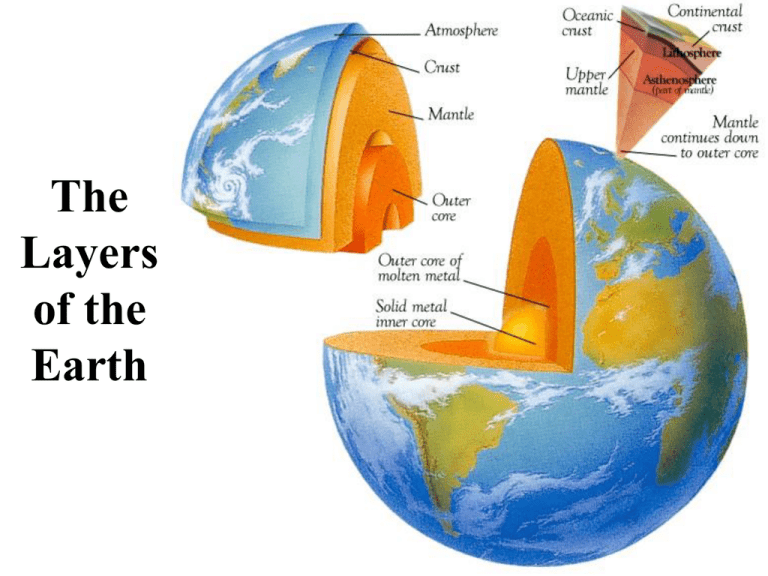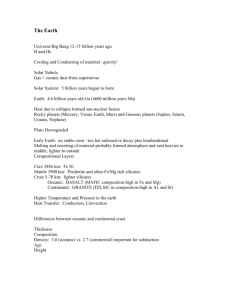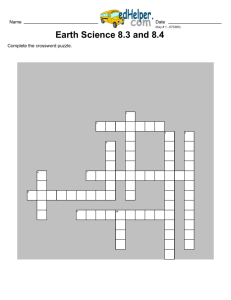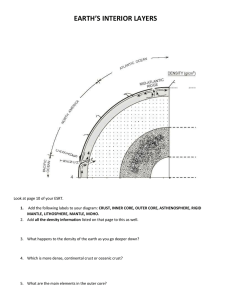
The
Layers
of the
Earth
The Layers of the Earth
© Copyright 2006. M. J. Krech. All rights reserved.
The Four Layers
The Earth is composed of four
different layers. The crust is
the layer that you live on, and
it is the most widely studied
and understood. The mantle
is much hotter and has the
ability to flow. The outer
core and inner core are
even hotter with pressures so
great you would be squeezed
into a ball smaller than a
marble if you were able to go
to the center of the Earth!
The Crust
The Earth's Crust is like
the skin of an apple. It is
very thin in comparison to
the other three layers. The
crust is only about 4-7
miles (6-11 kilometers)
thick under the oceans
(oceanic crust) and about
15-43 miles (25-70
kilometers) thick under the
continents (continental
crust).
The Lithospheric Plates
The crust of the Earth is broken into many pieces called
plates. The plates "float" on the soft, semi-rigid
asthenosphere.
The Asthenosphere
The asthenosphere
is the semi-rigid
part of the middle
mantle that flows
like hot asphalt
under a heavy
weight.
The Lithosphere
The crust and the upper layer of the
mantle together make up a zone of rigid,
brittle rock called the Lithosphere.
The Crust
The crust is composed of two rocks. The continental
crust is mostly granite. The oceanic crust is basalt.
Basalt is much denser than the granite. Because of this
the less dense continents ride on the denser oceanic
plates. The Basalt is formed when hot material in the
upper mantle is decompressed, allowing it to melt and
form liquid magma, which cools off quickly.
Oceanic crust
The rocks of the oceanic crust are very young, not
older than 200 million years, compared with the
rocks of the continental crust 3.6 billion years old.
The decompression
occurs beneath rifts in
the crust, such as those
found at the mid-ocean
ridges, and it is
through these rifts that
lava is extruded onto
the surface to create
new ocean crust.
Oceanic crust
• Oceanic crust is continuously being created at midocean ridges. At these ridges, magma rises into the
upper mantle and crust, as the plates diverge. As it
moves away from the ridge, the lithosphere
becomes cooler and denser, and sediment gradually
builds on top of it.
• The youngest oceanic lithosphere is at the oceanic
ridges, and is progressively older away from the
ridges.
Continental crust
• The continents include a wide range of rock types,
including granitic igneous rocks, sedimentary
rocks, and the metamorphic rocks formed by the
alterations of both. They contain a lot of quartz, a
mineral absent in oceanic crust.
• This core foundation is often referred to as a shield
or basement rock. Rocks found in the shields were
formed during the Precambrian and are some of
the oldest rocks found on the Earth.
Continental crust
• The first continental rocks were the result of
repeated melting, cooling, and remixing of
oceanic crust, driven by volcanic activity above
mantle convection cells, which were much more
numerous and vigorous than today’s.
• Geologists believe that the major continental cores
were formed by the early solidification of the
lighter components of magma between 3.9 and 3.8
billion years ago.
Continental crust
• The continental shields are generally covered by
younger sedimentary deposits. These sedimentary
rocks constitute the interior platforms of the
continents
The Mantle
The Mantle is the
largest layer of the Earth.
The middle mantle is
composed of very hot
dense rock that flows like
asphalt under a heavy
weight. The movement of
the middle mantle
(asthenosphere) is the
reason that the crustal
plates of the Earth move.
Convection Currents
The middle mantle "flows"
because of convection
currents. Convection
currents are caused by the
very hot material at the
deepest part of the mantle
rising, then cooling and
sinking again --repeating
this cycle over and over.
Convection Currents
The next time you heat anything like
soup or water in a pan you can watch
the convection currents move in
the liquid. When the convection
currents flow in the asthenosphere
they also move the crust. The crust
gets a free ride with these currents,
like the cork in this illustration.
Safety Caution: Don’t get your face
too close to the boiling water!
The Outer Core
The core of the Earth
is like a ball of very
hot metals. The
outer core
is so
hot that the metals in
it are all in the liquid
state. The outer core
is composed of the
melted metals of
nickel and iron.
The Inner Core
The inner core of
the Earth has
temperatures and
pressures so great that
the metals are
squeezed together and
are not able to move
about like a liquid, but
are forced to vibrate in
place like a solid.
The End
BONUS:
Find a pair or trio and answer
this question:
Have we ever seen part
of the Mantle? Explain.
© Copyright 2006. M. J. Krech. All rights reserved.







